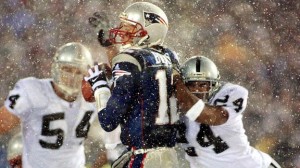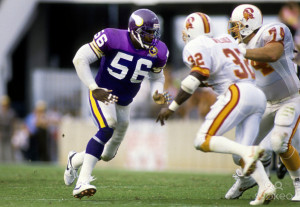Now the real question? Where does Woodson rank among players who returned to their original team? I’m going to institute a five-year rule on the amount of time that must be spent away from the first franchise, which both narrows down the list and meets the spirit of the post. Otherwise we’ll have to include people like Jason Taylor was in Miami from 1997 to 2007, Washington in 2008, Miami in 2009, the Jets in 2010, and the Dolphins again in 2011. Instead, the list will be dominated by one franchise, which holds my top three spots. See if you can figure it out before you get to the bottom. And my apologies for not putting this in a slideshow.
#10: Herschel Walker, Dallas Cowboys (1986-1989; 1996-1997)
Walker is remembered for the Herschel Walker trade, which helped the Cowboys win the Super Bowl in 1992, 1993, and 1995. Walker returned in ’96, but alas, Dallas’ window had already been closed by then. It’s a shame that Walker’s production is not how his career is defined, because he was a Hall of Fame caliber back. After winning the Heisman Trophy in 1982, Walker joined the USFL and led the league with 1,812 rushing yards in 1983. Two years later, Walker had an even more dominant season for the New Jersey Generals: he rushed for 2,411 yards and 21 touchdowns and caught 37 passes for 467 yards. Walker then joined the Cowboys and gained 5,199 yards from scrimmage in his first three years, the second highest total in the league over that span behind Eric Dickerson. That prompted the Herschel Walker trade to the Vikings, where Walker did not prove to be the player to put the Vikings over the top in the NFC. Walker spent time with the Eagles and Giants before a 34-year-old Walker joined the Cowboys for two throwaway seasons.
#9: Earnest Byner, Cleveland Browns (1984-1988; 1994-1995)
Byner teamed with Kevin Mack to become the second pair of teammates to rush for 1,000 yards in 1985, and in a 1987 playoff game, Byner rushed for 67 yards, caught 7 passes for 120 yards, and scored two touchdowns for the Browns. Unfortunately, he fumbled at the end of the game, which soon became known as The Fumble. Byner went to Washington and was one of the game’s better backs from ’89 to ’92. He came back to Cleveland in 1994 at the age of 32, and led the ’95 Browns team with 926 yards from scrimmage. That was the last year of the old Browns, and Byner played two more years with the Ravens before retiring.
#8: Warrick Dunn, Tampa Bay Buccaneers (1997-2001; 2008)
Dunn gained 7,690 yards from scrimmage in six years with the Bucs and 7,616 yards in six years with the Falcons. Dunn was the ’97 Offensive Rookie of the Year, the 2004 Walter Payton Man of the Year, and a three-time Pro Bowler. For his career, he ranks 17th in yards from scrimmage. Dunn was the model of consistency in his career, gaining at least 1,000 yards from scrimmage in 11 of 12 seasons (and 958 in the twelfth). How’s this for a good bit of trivia: Jerry Rice and Emmitt Smith are the only players with more seasons of 1,000 yards from scrimmage. Both Rice and Smith are at 14, while Dunn, Marcus Allen, and Marshall Faulk are all tied for third with eleven such seasons.
#7: Charles Haley, San Francisco 49ers (1986-1991; 1998-1999)
Haley recorded 63.5 sacks in six seasons in his first tour with the 49ers, which also netted him a pair of Super Bowl rings. Despite that production, Haley wore out his welcome so much in San Francisco that the team traded him to the Cowboys in August 1992 for a second and third round pick. With the Cowboys, Haley recorded 33 sacks from ’92 to ’95 and picked up three more Super Bowl rings. He retired after an injury-plagued 1996 season, but came out of retirement at age 34 to join the 49ers, and in ’99, he had three sacks in his final season in the NFL. While not yet in the Hall of Fame, Haley is part of an even more exclusive club: he’s the only player to ever win five Super Bowls. Although he isn’t one of the three players to win six NFL titles.
#6: Charles Woodson, Oakland Raiders (1998-2005; 2013-??)
Is Woodson a future Hall of Famer? The eight Pro Bowls, Defensive POTY Award, and Super Bowl ring will help, and things like the Heisman and high draft status have kept Woodson in the national spotlight for close to two decades. Woodson was a great corner almost immediately for the Raiders, but his play really fell off his final few seasons in Oakland. He missed games in each season from 2003 to 2006, and some thought he was washed up when the 30-year-old corner signed with the Packers. But Woodson found the fountain of youth in Green Bay, making four more Pro Bowls and recording 38 interceptions in seven years. His return to Oakland is somewhat peculiar in that the Raiders are nowhere near being a Super Bowl contender, but the Raiders might be the only team willing to guarantee him a starting job at free safety.
#5: Joe DeLamielleure, Buffalo Bills (1973-1979; 1985)
DeLamielleure may be unfamiliar to modern fans, but he was a Hall of Fame guard with the Bills in the ’70s. He was also the anchor of the Electric Company, the group of men responsible for turning on The Juice. DeLamielleure was an AP first-team All-Pro in ’75, ’76, and ’77, and a 1st-team Al-Pro pick of multiple other organizations in ’78, ’79, and ’80, too. He went to Cleveland in 1980, which got him to town just in time for Red Right 88. After five years with the Browns, DeLamielleure returned to Buffalo in 1985 but was out of juice himself: he played in just ten games, starting three, before retiring.
#4: Paul Warfield, Cleveland Browns (1964-1969; 1976-1977)
A halfback at Ohio State, Warfield exploded onto the NFL scene with 920 receiving yards and 9 touchdowns as a rookie with the Browns in 1964. Warfield was one of the game’s best receivers in the late ’60s, but Cleveland traded him to the Dolphins to land the #3 pick in the 1970 draft to select quarterback Mike Phipps (spoiler: it did not work out for Cleveland). Warfield won two Super Bowls with Miami, and his time there was very unique for a Hall of Fame receiver. Warfield joined Larry Csonka and Jim Kiick in departing the NFL for the World Football League in 1975, before returning to Cleveland for the final two years of his career.
#3: Chris Doleman, Minnesota Vikings (1985-1993; 1999)Doleman was part of a star-studded Pittsburgh program in the early ’80s before being selected by the Vikings with the 4th pick in the 1985 Draft. After recording just 3.5 sacks in his first two years, Doleman picked up 85 sacks over his next seven seasons, including a league-leading 21 in 1989. Doleman teamed with Keith Millard to form a terrifying pass rush on the quarterback’s blind side, and the Vikings were always a tough out in a loaded NFC. Doleman picked up two sacks in Minnesota’s huge upset victory over the 49ers in the playoffs after the 1987 season. In 1994, Minnesota traded Doleman to Atlanta to move up in the second round of the ’94 Draft and for Atlanta’s first round pick in 1995 (which turned into defensive end Derrick Alexander). Doleman had two solid years with the Falcons but then produced three outstanding years in San Francisco, as he picked up 38 sacks at ages 35, 36, and 37. He returned to the Vikings and still was able to record 8 sacks in 14 games in 1999, and Doleman ranks 4th on the list of career sacks since 1982.
#2: Randy Moss, Minnesota Vikings (1998-2004; 2010)
Like Walker and Byner, Moss will never be remembered solely for his good days on the field. Moss led the NFL in touchdowns five times, and did so as a Viking in ’98, ’00, and ’03. Moss is the single-season record holder for receiving touchdowns and ranks second to Jerry Rice on the career list. He’s third in career receiving yards, but there will be some who think Moss isn’t even worthy of Canton. That’s silly, but Moss’ baggage undercut too much of his production.
At his best, Moss revived the career of Randall Cunningham, turned Daunte Culpepper into a superstar, and helped Tom Brady reach the quarterback mountaintop. At his worst, Moss was a distraction, and his 2006 season in Oakland was unforgivable. He had one of the all-time great seasons the next year, but wore out his welcome in New England just two years later. He was traded to the Vikings during the 2010 season for the pick that turned into Ryan Mallett. In Moss’ first game back with Minnesota, he caught a 37-yard touchdown pass from Brett Favre that just so happened to be Favre’s 500th career touchdown pass.
The honeymoon didn’t last long: Moss was released by the Vikings a few weeks later, and played out the rest of the year with the Titans and did his best Randy Moss 2006 impersonation. He made it back to the Super Bowl last year with the 49ers, but again came up short in his quest for his first ring.
#1: Fran Tarkenton, Minnesota Vikings (’61-66; ’72-’78)
Unless Adrian Peterson changes teams and then comes back to Minnesota, Tarkenton’s spot at the top is safe. Tarkenton was the first quarterback for the expansion Vikings and produced arguably the best first game ever. In a 37-13 victory over the Bears, he completed 17 of 23 passes for 250 yards and 4 touchdowns, and ran for a fifth score. Tarkenton was just 21 years old as a rookie but managed to post respectable numbers for a bad team. The Vikings were improving by the mid-’60s and Tarkenton made back-to-back Pro Bowls in ’64 and ’65. But after the ’66 season, Tarkenton vowed not to play for the Vikings again, and he was traded to the Giants for four draft picks, including two first rounders. The terms of the trade have an interesting back story, but Minnesota received running back Clint Jones, HOF left tackle Ron Yary, wide receiver Bob Grim, and guard Ed White from the Giants draft picks.
In New York, Tarkenton was stuck on another mediocre team, but he made the Pro Bowl in each of his first four seasons with the Giants. After a down season at age 31 in 1971, New York traded him back to the Vikings. Minnesota was a quarterback away from being a Super Bowl contender, so they traded backup quarterback Norm Snead, Bob Grim, running back Vince Clements, and two picks (that turned into Larry Jacobson and Brad Van Pelt) to the Giants to reacquire Tarkenton.
The Vikings weren’t able to win a Super Bowl, but Tarkenton gave them just about everything else. From 1972 to 1978, Tarkenton guided the Vikings to a 64-27-2 record and three NFC Championships. He won the MVP and OPOY Awards in 1975, and made the Pro Bowl in ’74, ’75, and ’76. When he retired, Tarkenton had set every major passing record, along with this bit of trivia.


